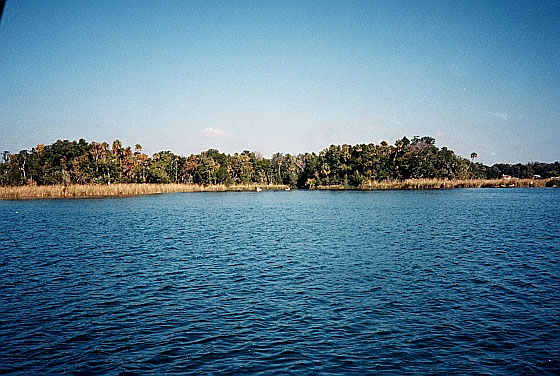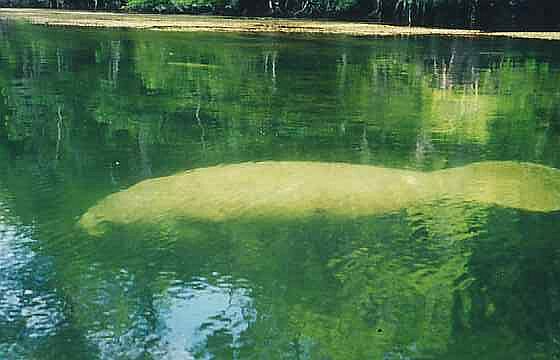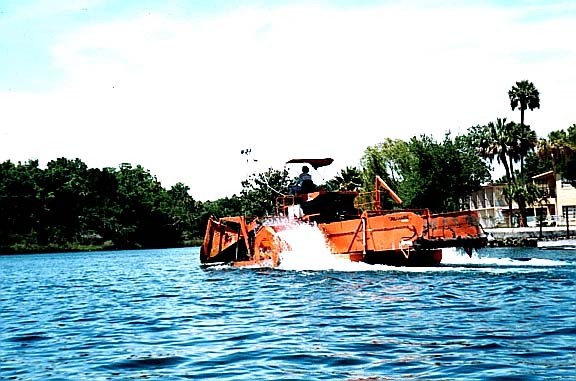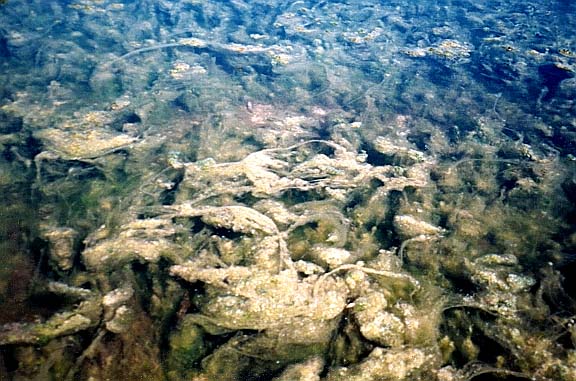Crystal River/King’s Bay Springs Group

Crystal River flows from a spring-fed bay in Citrus County on Florida’s west coast. For a relatively small area—King’s Bay is about 1.5 miles long and a mile across—it is perhaps the greatest concentration of springs in the state. As far as the authors could glean from published sources, about 30 springs have been formally identified in and around King’s Bay. However, local residents informed the authors that there were many more small springs in the bay, along Crystal River, and in the inlets that feed the bay and river along its course to the Gulf of Mexico. One resident, a manatee tour outfitter, opined that there were over 100 springs.
The bay has five large (1,000+ feet in length) and several small islands. Water flows north from King’s Bay into Crystal River and thence about five miles NW to the Gulf. Most of the identified "Crystal River" springs are actually in King’s Bay, on the eastern side on a very rough north/south line about a mile long. The majority are along the eastern edges of the bay and/or in the vicinity of Banana Island. Curiously (and unlike other coastal submarine springs in Florida), the flow of the Crystal River/King’s Bay springs diminishes during the summer (when rainfall is heavier) and at high tide (Rosenau et al., 1977, p. 83).
Crystal River/King’s Bay is famed as both a dive and manatee mecca. Several of the larger springs have cavern systems and are very popular with divers. There are dive outfitters in the adjoining town, which is named for Crystal River. Because the bay and river are so rich in springs—which maintain a constant temperature—they attract manatees in large numbers from October-March each winter. Over 200 manatees have been counted in the bay on a single day. These slow-moving, plant-eating mammals can also be seen in the bay and river throughout the year, albeit in smaller numbers during warm weather.
As there are for divers, there are also several local outfitters offering opportunities to "swim with the manatees." Pontoon boats take people to spots where manatees congregate, and visitors can enter the water for a possible close encounter. Rules govern human/manatee interaction: one may touch a manatee that approaches on its own, but people are not allowed to chase/follow aggressively, feed/lure, ride, rope, or otherwise harass the manatees. From October through March, areas around several springs are roped off from all boats to protect the manatees that congregate in springs to keep warm.
Since they have no natural enemies, manatees are unafraid of people. Man is, however, their only threat, and the combination of habitat loss, pollution, and collisions with boat propellers has reduced their numbers to about 6,000 total. Manatees are officially protected as an endangered species.
RB visited Kings/Mullet’s Gullet/Grand Canyon springs in 1997, and JF joined RB on a systematic spring search in King’s Bay in May 2001. We were both delighted and shocked by what we saw. Some of the springs—especially Hunter, Three Sisters, and Kings/Mullet’s Gullet/Grand Canyon—are spectacular sights. King’s Bay offers sweeping views and excellent opportunities for recreation. However, the bay, river, and springs are also grossly polluted and infested with both exotic water plants and algae growth/blooms. Water clarity is dramatically reduced from historic levels, and native flora and fauna populations have fallen.
Sources of the problems include fertilizer and road runoff, and leaking/seepage from inadequate septic systems. Nearly every inch of land around the bay is developed for housing or commerce, and many of these structures have old septic systems. Natural inlets have been extended via numerous canals to provide watercraft access to homeowners, and these seawall-lined backwaters are generally the most badly polluted and plant-choked areas. The level of salinity in King's Bay varies according to the tide, levels of rainfall, the amount of discharge from the springs. Nitrate levels are elevated in the bay and vary from spring to spring.
At the public park at Hunter (or American Legion) Spring, signs warn swimmers to shower off immediately after swimming to avoid getting rashes or skin lesions from the polluted water. Only a small percentage of the houses in Crystal River are on a city sewer system. A bill to pay to expand the sewer system was vetoed by Florida Governor John "Jeb" Bush in 2000.
When the authors visited the area in May 2001, they found only one spot that had very clear water and that was not infested with exotic plants or algae—the Three Sisters/Idiot’s Delight area. Local residents told the authors that the bay and Crystal River were much clearer in the past, and are also clearer in the mornings, at low tide, when the wind is calm, and during periods when there are not so many boats and divers stirring up the water.
A short story exemplifies conditions in parts of King’s Bay. While paddling in the Hunter (or American Legion) Spring run near Jurassic Spring in May 2001, the authors passed directly over 1-2 manatees that were probably resting or napping on the bottom. They had seen a mother manatee and its young earlier in the day in the area. The water was an unnatural—almost fluorescent—green, with visibility only about 6 inches. Even though the bottom was only 4-5 feet deep, and a manatee actually struck the authors’ canoe and lifted it partially out of the water, they were only able to identify it when it briefly broke the surface.
A $400,000 investment of city, county, and state funds for clean-up in 1997 purchased machinery to attack and remove aquatic vegetation. The contraption in the photo below tears plants from the bottom and also has a conveyor belt to remove vegetation. The authors did not see the conveyor belt in use, but observed the machine churning up the bottom. This approach may help but is clearly not a long-term solution.
Besides the plant-clearing machines, some other steps have been taken to help protect the Crystal River area. The large islands in King’s Bay have been included in the Crystal River National Wildlife Refuge, and there are seven other manatee sanctuaries during the winter months. Most recently, Three Sisters Springs was declared a manatee refuge from November 15-March 31 each year. At the same time, however, the owners of the land adjacent to Three Sisters sought permits to extract as much at 426,000 gallons of water from the springs each day. The issue is not resolved.
Crystal River is one of the world’s great sites for springs, manatees, diving, and recreation, but its health is bad and deteriorating. It is in critical need of action to attenuate and ameliorate the problems caused by development, pollution, and exotic infestation. Visitors must already dive through a poison layer to reach Hunter (or American Legion) Spring, and Jurassic Spring is the most polluted-looking spring the authors have ever seen. Unless action—in the form of stricter regulations, better clean-up, exotic removal, and support for expanding modern sewer systems—the crown jewels of King’s Bay (like Three Sisters) may soon suffer a similar fate.





